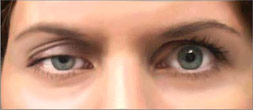What
is
Myasthenia
Gravis
(MG)?
The term
Myasthenia
gravis
means
grave
muscle
weakness.
MG is a
chronic
progressive
auto-immune
disorder
causing
muscle
weakness.
What
happens
in MG?
In MG,
there is
weakness
of
voluntary
muscles
(those
controlled
by will)
and easy
fatigability.
This
weakness
comes up
during
periods
of
exertion
and
improves
after
rest.
MG is an
abnormality
of the
transmission
of
signals
at the
Neuro-Muscular
Junction
(NMJ). (Signals travel from brain to muscles via the nerves and the place where nerve joins muscle is called neuro-muscular
junction.)
 |
Whom
can it
affect?
Females
are
affected
more
often
than
males
Age of
onset in
females
is
during
second
to third
decade
Onset
is after
sixth
decade
in males
2 out
of every
100000
people
are
affected
by MG |
|
Auto-immune
nature
of MG:
In MG,
the
bodys
defense
system
forms
cells
(antibodies)
against
acetyl choline
receptors
These
receptors
are
required
for
transmission
of
signals
across
the NMJ
When
these
receptors
are
blocked,
altered
or
destroyed
by the
antibodies,
muscle
contraction
cannot
occur
normally. |
Causes
of MG:
Genetic
Immunological
Thymus
tumors
or
abnormal
enlargement
(hyperplasia)
Stress
(aggravating
factor
in
existing
cases of
Myasthenia
Gravis)
Muscles
usually
affected
by MG:
Muscles
controlling
eye and
eyelid
movements
Muscles
of
facial
expression
Muscles
of
swallowing
Neck
and limb
muscles
Occasionally
respiratory
muscles
Symptoms
of MG:
Drooping
eyelids
(ptosis)
Double
vision (diplopia)
Difficulty
in
speech,
slurred
speech
Difficulty
in
swallowing
Nasal
sounding
speech
Weakness
of neck
muscles
Weakness
of arms
and legs
Symptoms
are
usually
intermittent
(i.e.
come and
go)
Symptoms
may
disappear
for
weeks
and may
appear
again,
later
Weakness
tends to
worsen
as the
day
progresses
and
after
prolonged
activity
Myasthenia
Crisis:
A
condition
in which
respiratory
muscles
become
severely
weakened
Patient
may have
breathlessness,
choking,
aspiration
of food
Myasthenia
crisis
is rare
and may
end in
respiratory
failure
Grades
of MG:
Grade
1: Only
ocular
disease
Grade
2A: Mild
generalized
weakness
Grade
2B:
Moderate
generalized
weakness
Grade
3:
Severe
generalized
weakness
Grade
4:
Myasthenia
crisis
Triggers
of
Myasthenia
Crisis:
Respiratory
viral
infections
Sudden
withdrawal
of
steroids
Certain
drugs
Psychological
stress
Pregnancy
Exertion
(especially
in hot
climate)
Diagnosis
of MG:
This is
mainly
based on
clinical
findings
and a
few
supportive
investigations:
Antibodies
to
acetyl
choline
receptors
EMG (Electromyogram)
Repetitive
nerve
stimulation
Tensilon
test
CT chest
(for
thymus
abnormalities)
Allopathic
treatment
mostly
includes:
Acetylcholine
esterase
inhibitors
(Pyridostigmine)
Steroids
Immunosuppressive
drugs
Plasmapheresis
(a
procedure
in which
abnormal
antibodies
are
removed
from the
blood)
Intravenous
immunoglobulin
(temporarily
modifies
the
immune
system
and
provides
the body
with
normal
antibodies
from
donated
blood)
Surgical
treatment:
Thymectomy
Homeopathic
approach
and
scope:
Myasthenia
Gravis
is an
autoimmune
disorder,
which
means
that
there is
a fault
with the
immune
system,
guided
by
genetic
tendencies
and
other
general
factors.
In other
words,
MG is a
constitutional
disorder,
where
the
whole
constitution
needs to
be
addressed.
MG is a
progressively
deteriorating
condition,
calling
for some
measures
to
arrest
or
control
the
disease
process.
Homeopathic
treatment
being
constitutional
in
nature,
treats
the
disease
at a
deeper
level,
to
achieve
the
following:
Control
of the
disease
process
Symptomatic
relief
Homeopathy
has
shown
its
efficacy
in
reducing
the
frequency
of
relapses
and
improving
the
power
and tone
of
muscles.
However,
it may
be noted
that the
improvement
with
homeopathy
may not
be as
fast as
one
achieved
by using
the
immunosuppressive
medicines.
The role
of
homeopathy
is more
as long
term
control,
rather
than for
acute
crisis
control.
Homeopathy
with its
constitutional
approach
works at
deeper
level
and
brings
deviations
of
immune
system
back to
normalcy
and in
consequence
minimizes
the need
of
exogenous
neurotransmitters
or
steroids
as
prescribed
by
conventional
treatment.
Suggestion
about
homeopathic
treatment:
For
achieving
the best
results
in the
cases of
MG, we
recommend
a
strategic
combination
of
homeopathy
with the
conventional
treatment.
|
|
|
|
Click
here for Case
Studies |
|
|




















